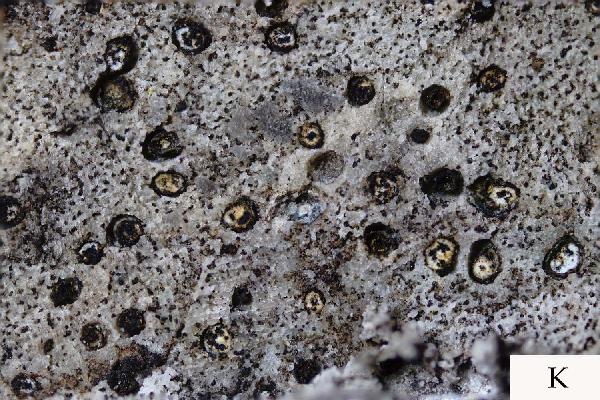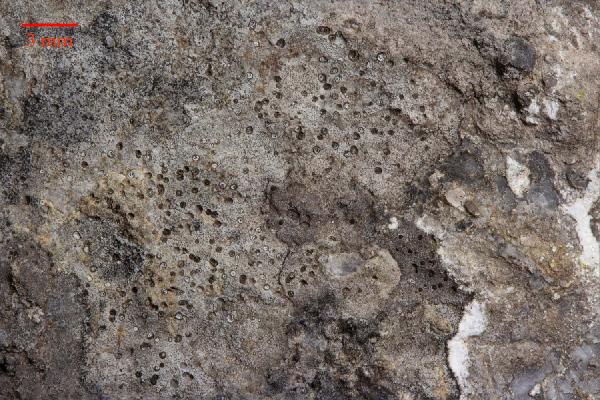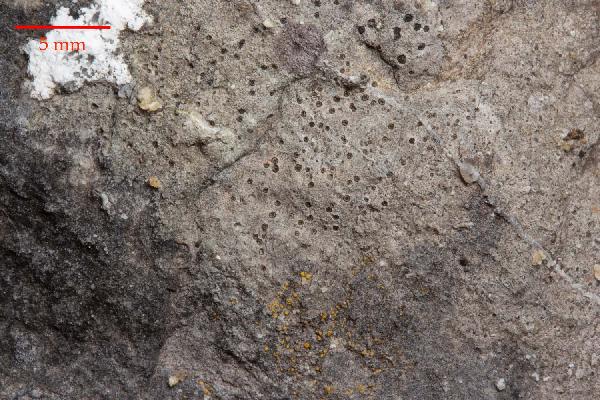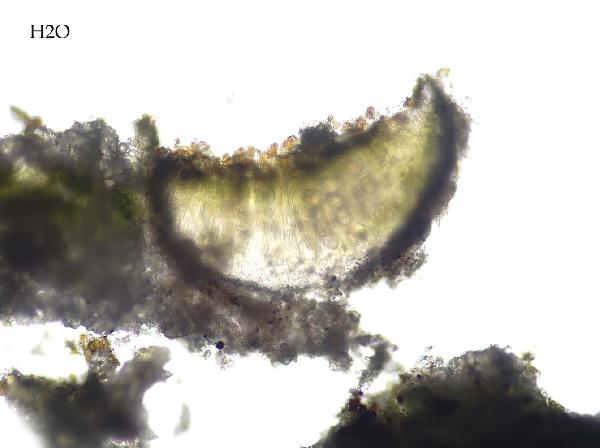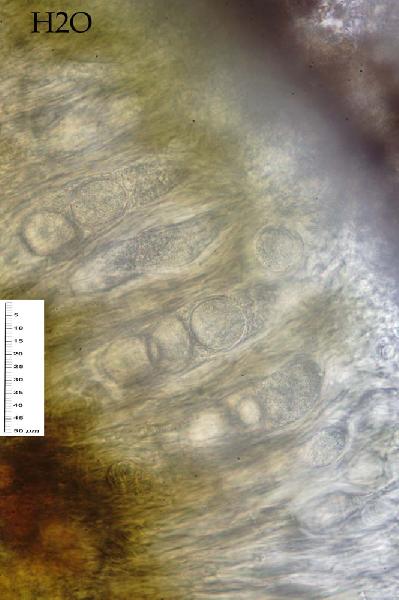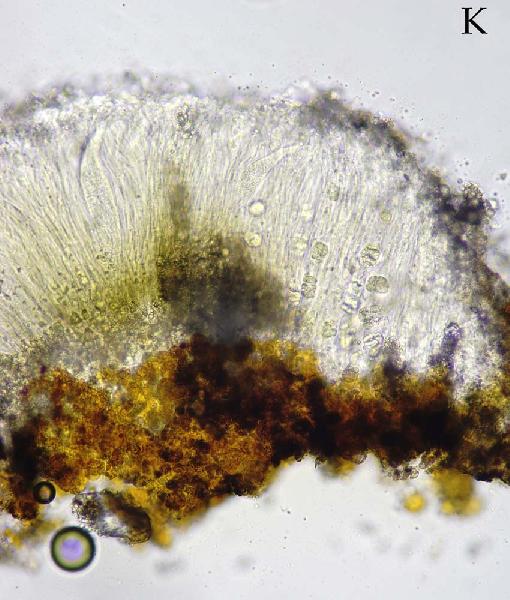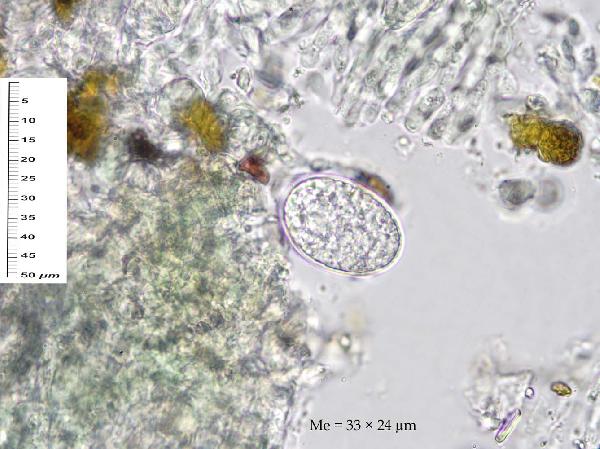Circinaria coronata (A. Massal.)
Provisionally placed here, ICN Art. 36.1b.. Basionym: Pachyospora coronata A. Massal. - Mem. Lichenogr.: 131, 1853.
Synonyms: Aspicilia calcarea var. coronata (A. Massal.) Körb.; Aspicilia coronata (A. Massal.) B. de Lesd.; Aspicilia coronata var. petkae (Servít) Szatala?; Aspicilia laurensii B. de Lesd.; Lecanora coronata (A. Massal.) Jatta; Lecanora coronuligera Zahlbr.; Lecanora laurensii (B. de Lesd.) Croz.
Description: Thallus crustose, endosubstratic or thinly episubstratic, continuous to finely rimose around the apothecia, grey-white to pale yellowish green, dull, N+ green. Medulla white, I-. Apothecia aspicilioid, 0.2-0.5 mm across, usually immersed in pits of the rock, round to strongly irregular in outline, with a black, but usually densely white-pruinose, concave to flat disc and a thin, slightly raised, white thalline margin. Proper exciple poorly developed, colourless; epithecium olive green to olive-brown, with crystals, N+ emerald green, K+ brownish; hymenium colourless, I+ blue partly turning yellow-green; paraphyses sparingly branched and anastomosing, 1.5-2 µm thick at mid-level, submoniliform in upper part, the uppermost cells subglobose, up to 6 µm wide; hypothecium colourless. Asci (2-)4(-6)-spored, cylindrical-clavate. Ascospores 1-celled, hyaline, broadly ellipsoid to subglobose, 18-34 x 13-28 µm. Pycnidia rare, immersed, with a black, punctiform ostiole. Conidia filiform, straight or slightly curved, 6-11 µm long. Photobiont chlorococcoid. Spot tests: cortex and medulla K-, C-, KC-, P-. Chemistry: aspicilin.
Growth form: Crustose endolithic
Substrata: rocks
Photobiont: green algae other than Trentepohlia
Reproductive strategy: mainly sexual
Commonnes-rarity: (info)
Alpine belt: rare
Subalpine belt: rather rare
Montane belt: common
Dry submediterranean belt: very rare
Humid submediterranean belt: very rare
Padanian area: absent
pH of the substrata:
1 2 3 4 5
Solar irradiation:
1 2 3 4 5
Aridity:
1 2 3 4 5
Eutrophication:
1 2 3 4 5
Poleotolerance:
0 1 2 3
Altitudinal distribution:
1 2 3 4 5 6
Rarity
absent
extremely rare
very rare
rare
rather rare
rather common
common
very common
extremely common
Loading data...
Occurrence data
Predictive map

P.L. Nimis; Owner: Department of Life Sciences, University of Trieste
Herbarium: TSB (16406)
2001/11/22

Courtesy Danièle et Olivier Gonnet - Source: https://www.afl-lichenologie.fr/Photos_AFL/Photos_AFL_A/Textes_A4/Aspicilia_coronata.htm
France, Salignac-Eyvigues - (24) - route vers Barbeyroux, près de Bourzolles, alt. 200 m
18/03/2015

Courtesy Danièle et Olivier Gonnet - Source: https://www.afl-lichenologie.fr/Photos_AFL/Photos_AFL_A/Textes_A4/Aspicilia_coronata.htm
France, Salignac-Eyvigues - (24) - route vers Barbeyroux, près de Bourzolles, alt. 200 m
18/03/2015
Growth form: Crustose endolithic
Substrata: rocks
Photobiont: green algae other than Trentepohlia
Reproductive strategy: mainly sexual
Commonnes-rarity: (info)
Alpine belt: rare
Subalpine belt: rather rare
Montane belt: common
Dry submediterranean belt: very rare
Humid submediterranean belt: very rare
Padanian area: absent
pH of the substrata:
| 1 | 2 | 3 | 4 | 5 |
Solar irradiation:
| 1 | 2 | 3 | 4 | 5 |
Aridity:
| 1 | 2 | 3 | 4 | 5 |
Eutrophication:
| 1 | 2 | 3 | 4 | 5 |
Poleotolerance:
| 0 | 1 | 2 | 3 |
Altitudinal distribution:
| 1 | 2 | 3 | 4 | 5 | 6 |
Rarity
absent
extremely rare
very rare
rare
rather rare
rather common
common
very common
extremely common
Loading data...
Occurrence data
Predictive map

P.L. Nimis; Owner: Department of Life Sciences, University of Trieste
Herbarium: TSB (16406)
2001/11/22

Courtesy Danièle et Olivier Gonnet - Source: https://www.afl-lichenologie.fr/Photos_AFL/Photos_AFL_A/Textes_A4/Aspicilia_coronata.htm
France, Salignac-Eyvigues - (24) - route vers Barbeyroux, près de Bourzolles, alt. 200 m
18/03/2015








